Effects of Different Soil Moisture Contents on Rumen Fluids in Promoting Straw Decomposition after Straw Returning
Abstract
1. Introduction
2. Materials and Methods
2.1. Rumen Fluids, Soil, and Rice Straw Collection
2.2. Experimental Design
2.3. Analytical Methods
2.4. Statistical Analysis
3. Results and Discussion
3.1. Variations in the Degradation Rate of Straw
3.2. Structure and Chemistry Characterizations of Straw Materials
3.3. Soil Enzyme Activities
3.4. Soil Nutrients
3.5. Soil Microorganisms
4. Conclusions
Author Contributions
Funding
Acknowledgments
Conflicts of Interest
References
- Pancholi, M.J.; Khristi, A.; Bagchi, D. Comparative analysis of lignocellulose agricultural waste and pre-treatment conditions with ftir and machine learning modeling. BioEnergy Res. 2022, 16, 123–137. [Google Scholar] [CrossRef]
- Zhang, N.; Tian, C.; Fu, P.; Yuan, Q.; Zhang, Y.; Li, Z. The fractionation of corn stalk components by hydrothermal treatment followed by ultrasonic ethanol extraction. Energies 2022, 15, 2616. [Google Scholar] [CrossRef]
- Cheng, C.; Wang, J.J.; Cheng, H.H.; Luo, K.; Zeng, Y.J.; Shi, Q.H. Effects of straw returning and tillage system on crop yield and soil fertility quality in paddy field under double-cropping-rice system. Acta Pedol. Sinica. 2018, 55, 247–257. [Google Scholar]
- Wang, Y.J.; Wang, N.; Huang, G.Q. How do rural households accept straw returning in northeast china? Resour. Conserv. Recycl. 2022, 182, 106287. [Google Scholar] [CrossRef]
- Liu, Y.L.; Gu, Y.; Wu, C.S.; Zhao, H.X.; Hu, W.H.; Xu, C.; Chen, X.F. Short-term straw returning improves quality and bacteria community of black soil in northeast china. Pol. J. Environ. Stud. 2022, 2 Pt 2, 31. [Google Scholar]
- Crecchio, C.; Curci, M.; Pellegrino, A.; Ricciuti, P.; Tursi, N.; Ruggiero, P. Soil microbial dynamics and genetic diversity in soil under monoculture wheat grown in different long-term management systems. Biochemistry 2007, 39, 1391–1400. [Google Scholar] [CrossRef]
- Lenka, N.K.; Lal, R. Soil aggregation and greenhouse gas flux after 15 years of wheat straw and fertilizer management in a no-till system. Soil Tillage Res. 2013, 126, 78–89. [Google Scholar] [CrossRef]
- Khaliq, A.; Matloob, A.; Farooq, M.; Mushtaq, M.N.; Khan, M.B. Effect of crop residues applied isolated or in combination on the germination and seedling growth of horse purslane (Trianthema portulacastrum). Planta Daninha 2011, 29, 121–128. [Google Scholar] [CrossRef]
- Su, P.; Brookes, P.C.; He, Y.; Wu, J.; Xu, J. An evaluation of a microbial inoculum in promoting organic C decomposition in a paddy soil following straw incorporation. J. Soils Sedim. 2016, 16, 1776–1786. [Google Scholar] [CrossRef]
- Li, S.; Zhang, Y.; Wang, Y.; Zhen, L.W. The control effect of a multifunctional bacterial agent fit for straw amendment against wheat soil-borne diseases. Front. Agric. China 2011, 5, 305–309. [Google Scholar] [CrossRef]
- Chen, Y.; Zhao, R.; Jia, L.; Wang, L.; Pan, C.; Zhang, R. Microbial inoculants reshape structural distribution of complex components of humic acid based on spectroscopy during straw waste composting. Bioresour. Technol. 2022, 359, 127472. [Google Scholar] [CrossRef]
- Ulrich, A.; Klimke, G.; Wirth, S. Diversity and Activity of Cellulose-Decomposing Bacteria, Isolated from a Sandy and a Loamy Soil after Long-Term Manure Application. Microb. Ecol. 2007, 55, 512–522. [Google Scholar] [CrossRef]
- Liu, Y.; Li, L.; Li, J.; Guan, D.W.; Jiang, X.; Shen, D.L.; Du, B. Construction and Composition Analysis of the Complex Microbial System CSS-1 of High Decomposition Efficiency for Corn Stalks. Sci. Agric. Sin. 2011, 43, 4437–4446. [Google Scholar]
- Song, K.; Zhou, C.; Li, H.; Zhou, Z.; Ni, G.; Yin, X. Effects of rumen microorganisms on straw returning to soil at different depths. Eur. J. Soil Biol. 2023, 114, 103454. [Google Scholar] [CrossRef]
- Sauer, S.; Fischer, W.-J. Passive wireless irreversible humidity threshold sensor exploiting the deliquescence behavior of salts. In Proceedings of the Paper presented at the SENSORS, 2012 IEEE, Taipei, Taiwan, 28–31 October 2012. [Google Scholar]
- Li, P.; Zhang, D.; Wang, X.; Wang, X.; Cui, Z. Survival and performance of two cellulose-degrading microbial systems inoculated into wheat straw-amended soil. J. Microbiol. Biotechnol. 2012, 22, 126–132. [Google Scholar] [CrossRef]
- Seesatat, A.; Rattanasuk, S.; Bunnakit, K.; Maneechot, P.; Sriprapakhan, P.; Artkla, R. Biological degradation of rice straw with thermophilic lignocellulolytic bacterial isolates and biogas production from total broth by rumen microorganisms. J. Environ. Chem. Eng. 2021, 9, 104499. [Google Scholar] [CrossRef]
- Chung, R.; Kang, E.Y.; Shin, Y.J.; Park, J.J.; Park, P.S.; Han, C.H.; Kim, B.; Moon, S.I.; Park, J.; Chung, P.S. Development of a Consolidated Anaerobic Digester and Microbial Fuel Cell to Produce Biomethane and Electricity from Cellulosic Biomass Using Bovine Rumen Microorganisms. J. Sustain. Bioenergy Syst. 2019, 9, 17–28. [Google Scholar] [CrossRef]
- Xing, B.-S.; Han, Y.; Wang, X.C.; Wen, J.; Cao, S.; Zhang, K.; Li, Q.; Yuan, H. Persistent action of cow rumen microorganisms in enhancing biodegradation of wheat straw by rumen fermentation. Sci. Total. Environ. 2020, 715, 136529. [Google Scholar] [CrossRef]
- Khalil, M.I.; Hossain, M.B.; Schmidhalter, U. Carbon and nitrogenmineralization in different upland soils ofthe subtropics treated withorganic materials. Soil Biol. Biochem. 2005, 37, 1507–1518. [Google Scholar] [CrossRef]
- Davidson, E.A.; Verchot, L.V.; Cattânio, J.H.; Ackerman, I.L. Controls on soil respiration: Implications for climate change. Effects of soil water content on soil respiration in forests and cattle pastures of eastern Amazonia. Biogeochemistry 2000, 48, 53–69. [Google Scholar] [CrossRef]
- Abera, G.; Wolde-Meskel, E.; Bakken, L.R. Carbon and nitrogen mineralization dynamics in different soils of the tropics amended with legume residues and contrasting soil moisture contents. Biol. Fertil. Soils 2012, 48, 51–66. [Google Scholar] [CrossRef]
- Sherman, C.; Grishkan, I.; Barness, G. Steinberger Y Fungal community—Plant litter decomposition relationships along a climate gradient. Pedosphere 2014, 24, 437–449. [Google Scholar] [CrossRef]
- Dong, L.; Yu-Yi, L.; Pang, H.; Sun, Q. Comparison of the effect of long-term fertilizer application on soil nutrients and wheat yield under different soil types. J. China Agric. Univ. 2010, 15, 22–28. [Google Scholar]
- Castro, H.; Classen, A.; Austin, E.; Norby, R.; Schadt, C. Soil microbial community responses to multiple expcrimental climate change drivers. Applied Environ. Microbiol. 2010, 76, 999–1007. [Google Scholar] [CrossRef]
- Segal, L.; Creely, J.J.; Martin, A.E., Jr.; Conrad, C.M. An Empirical Method for Estimating the Degree of Crystallinity of Native Cellulose Using the X-Ray Diffractometer. Text. Res. J. 1959, 29, 786–794. [Google Scholar] [CrossRef]
- Itodo, I.N.; Awulu, J.O. Effects of total solids concentrations of poultry, cattle, and piggerywaste slurries on biogas yield. Trans. Asae Am. Soc. Agric. Eng. 1999, 42, 1853–1855. [Google Scholar] [CrossRef]
- Zuo, R.; Zou, F.; Tian, S.; Masabni, J.; Yuan, D.; Xiong, H. Differential and Interactive Effects of Scleroderma sp. and Inorganic Phosphate on Nutrient Uptake and Seedling Quality of Castanea henryi. Agronomy 2022, 12, 901. [Google Scholar] [CrossRef]
- Magan, N.; Hand, P.; Kirkwood, I.A.; Lynch, J.M. Establishment of microbial inocula on decomposing wheat straw in soil of different water contents. Soil Biol. Biochem. 1989, 21, 15–22. [Google Scholar] [CrossRef]
- Manzoni, S.; Schimel, J.P.; Porporato, A. Responses of soil microbial communities to water stress: Results from a meta-analysis. Ecology 2012, 93, 930–938. [Google Scholar] [CrossRef]
- Yuste, J.C.; Penuelas, J.; Estiarte, M.; Garcia-mas, J.; Mattana, S.; Ogaya, R.; Pujol, M.; Sardans, J. Drought-resistant fungi control soil organic matter decomposition and its response to temperature. Glob. Chang. Biol. 2011, 17, 1475–1486. [Google Scholar] [CrossRef]
- Chen, L.; Zhang, J.B.; Zhao, B.Z.; Xin, X.L.; Zhou, G.X.; Tan, J.F.; Zhao, J.H. Carbon mineralization and microbial attributes in straw-amended soils as affected by moisture levels. Pedosphere 2014, 24, 167–177. [Google Scholar] [CrossRef]
- Chen, M.; Ma, Y.; Xu, Y.; Chen, X.; Zhang, X.; Lu, C. Isolation and characterization of cellulose fibers from rice straw and its application in modified polypropylene composites. Polym.-Plast. Technol. Eng. 2013, 52, 1566–1573. [Google Scholar] [CrossRef]
- Xu, J.; Xu, X.; Liu, Y.; Li, H.; Liu, H. Effect of microbiological inoculants DN-1 on lignocellulose degradation during co-composting of cattle manure with rice straw monitored by FTIR and SEM. Environ. Prog. Sustain. Energy 2016, 35, 345–351. [Google Scholar]
- Pan, M.; Gan, X.; Mei, C.; Liang, Y. Structural analysis and transformation of biosilica during lignocellulose fractionation of rice straw. J. Mol. Struct. 2017, 1127, 575–582. [Google Scholar]
- Li, M.; Wang, Z.; Sun, J.; Chen, W.; Hou, X.; Gao, Z. Synergistic effect of mixed fungal pretreatment on thermogravimetric characteristics of rice straw. Bioresources 2021, 16, 3978–3990. [Google Scholar]
- Wu, L.; Ma, H.; Zhao, Q.; Zhang, S.; Wei, W.; Ding, X. Changes in soil bacterial community and enzyme activity under five years straw returning in paddy soil. Eur. J. Soil Biol. 2020, 100, 103215. [Google Scholar]
- Han, W.; He, M. The application of exogenous cellulase to improve soil fertility and plant growth due to acceleration of straw decomposition. Bioresour. Technol. 2010, 101, 3724–3731. [Google Scholar]
- Rey, A.; Petsikos, C.; Jarvis, P.G.; Grace, J. Effect of temperature and moisture on rates of carbon mineralization in a Mediterranean oak forest soil under controlled and field conditions. Eur. J. Soil Sci. 2005, 56, 589–599. [Google Scholar] [CrossRef]
- Janz, B.; Havermann, F.; Lashermes, G.; Zuazo, P.; Engelsberger, F.; Torabi, S.M.; Butterbach-Bahl, K. Effects of crop residue incorporation and properties on combined soil gaseous N2O, NO, and NH3 emissions—A laboratory-based measurement approach. Sci. Total Environ. 2022, 807, 151051. [Google Scholar] [CrossRef]
- Bowen, S.R.; Gregorich, E.G.; Hopkins, D.W. Biochemical properties and biodegradation of dissolved organic matter from soils. Biol. Fertil. Soils 2009, 45, 733–742. [Google Scholar]
- Song, M.; Jiang, J.; Cao, G.; Xu, X. Effects of temperature, glucose and inorganic nitrogen inputs on carbon mineralization in a Tibetan alpine meadow soil. Eur. J. Soil Biol. 2010, 46, 375–380. [Google Scholar] [CrossRef]
- Neve, S.D.; Hofman, G. Quantifying soil water effects on nitrogen mineralization from soil organic matter and from fresh crop residues. Biol. Fertil. Soils 2002, 35, 379–386. [Google Scholar] [CrossRef]
- Semenov, M.V.; Krasnov, G.S.; Semenov, V.M.; Ksenofontova, N.; Zinyakova, N.B.; van Bruggen, A.H. Does fresh farmyard manure introduce surviving microbes into soil or activate soil-borne microbiota? J. Environ. Manag. 2021, 294, 113018. [Google Scholar]
- Xu, L.; Naylor, D.; Dong, Z.; Simmons, T.; Pierroz, G.; Hixson, K.K. Drought delays development of the sorghum root microbiome and enriches for monoderm bacteria. Proc. Natl. Acad. Sci. USA 2018, 115, E4284–E4293. [Google Scholar] [CrossRef] [PubMed]
- Li, H.J.; Peng, J.J.; Weber, K.A.; Zhu, Y.G. Phylogenetic diversity of Fe(I)-reducing microorganisms in rice paddysoil:enrichment cultures with different short-chain fatty acids as electron donors. J. Soils Sedim. 2011, 11, 1234–1242. [Google Scholar] [CrossRef]
- Kan, J.B.; Li, L.N.; Qu, D.; Wang, P.L. Changes in bacterial abundance and community structure of rice soils during flooding culture. Biodiversity 2014, 22, 508–515. [Google Scholar]
- Sar, P.; Kazy, S.K.; Paul, D.; Sarkar, A. Metal Bioremediation by Thermophilic Microorganisms. In Thermophilic Microbes in Environmental and Industrial Biotechnology; Satyanarayana, T., Littlechild, J., Kawarabayasi, Y., Eds.; Springer: Dordrecht, The Netherlands, 2013; pp. 171–201. [Google Scholar]
- Guo, Q.; Wang, W.; Liu, Y.; Wen, X.X.; Liao, Y.C. Effects of soil moisture and temperature on soil microbial ecological environment and soil respiration in rainfed wheat field. Res. Crops 2013, 14, 374–381. [Google Scholar]
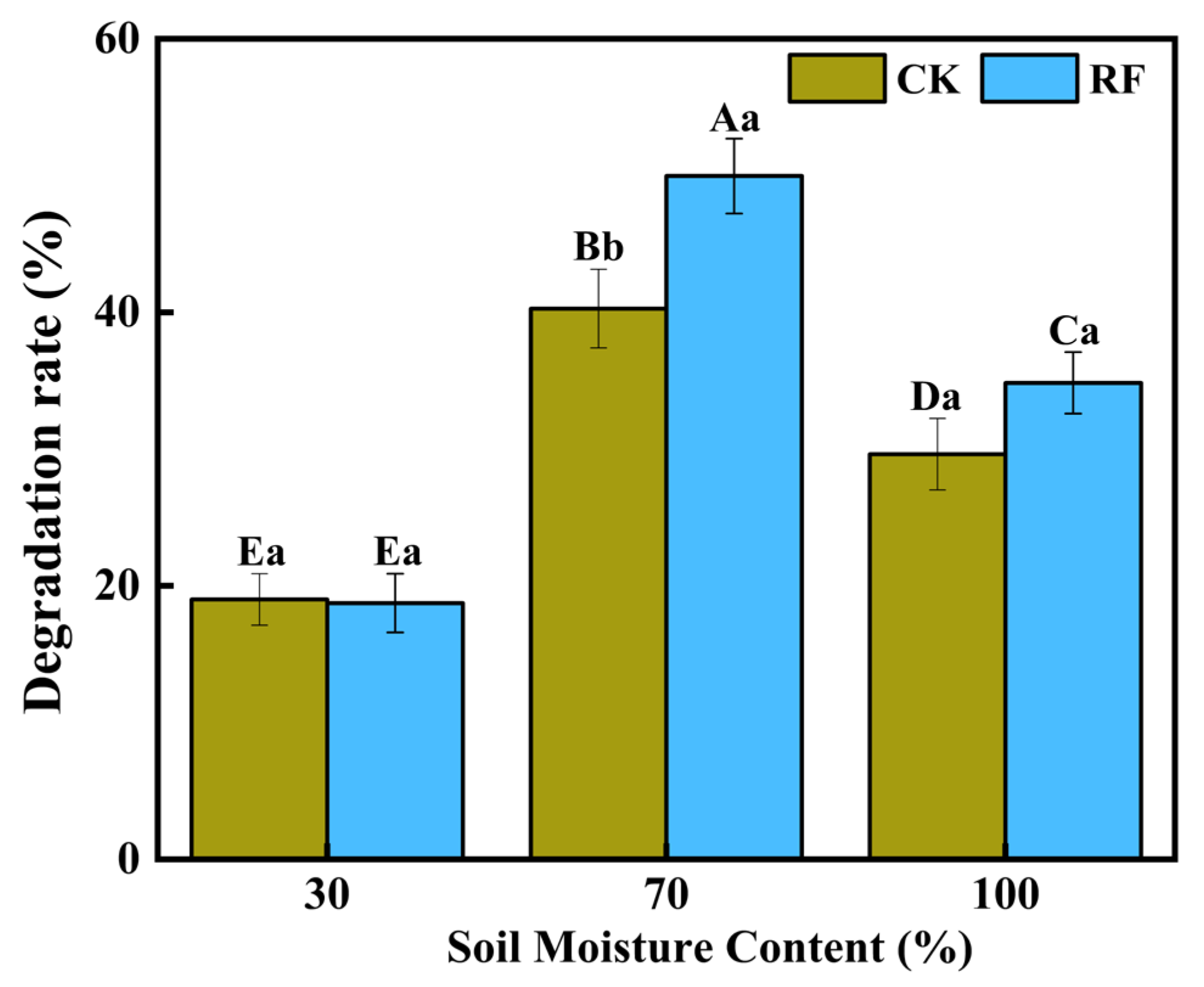
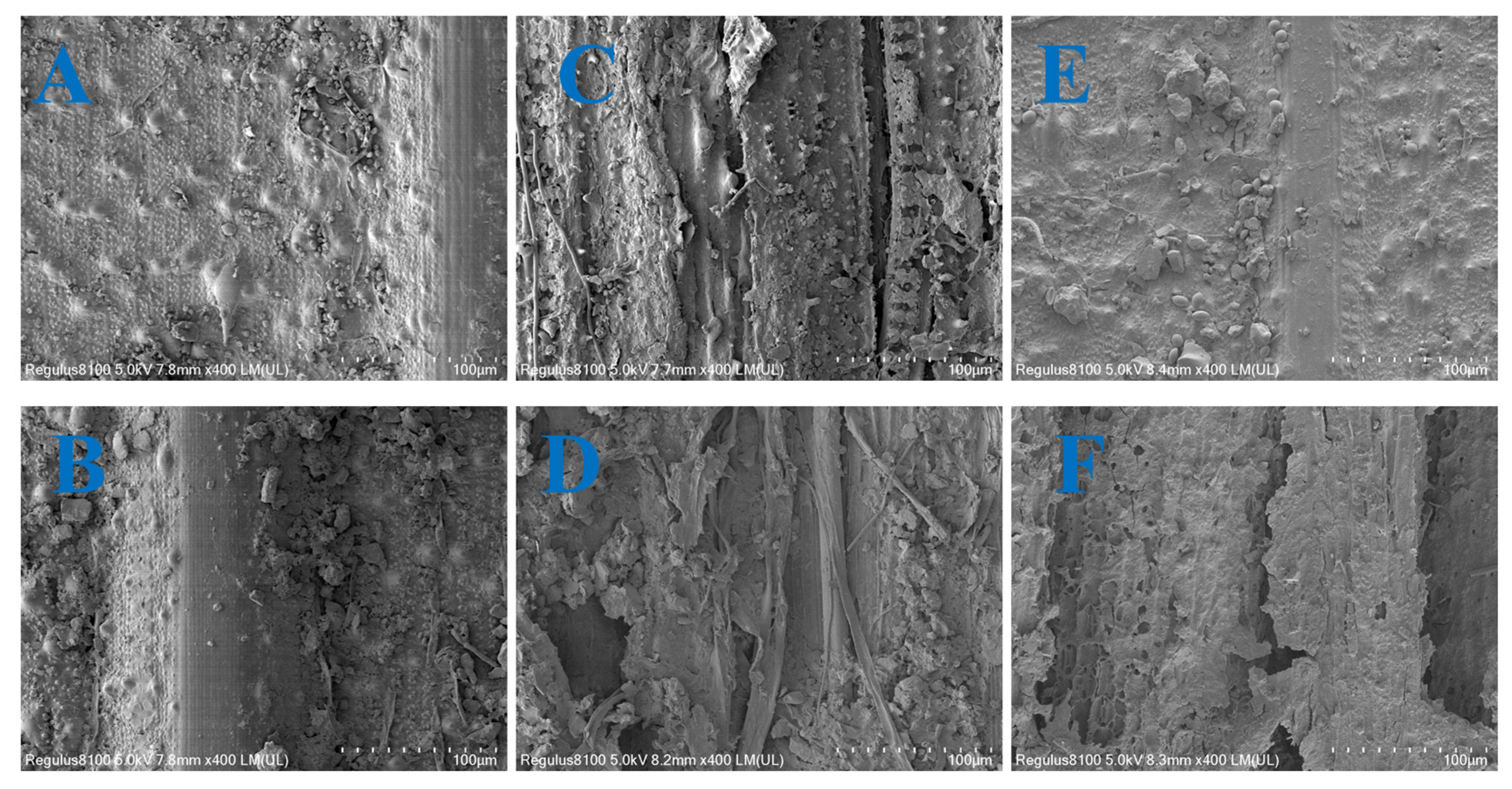
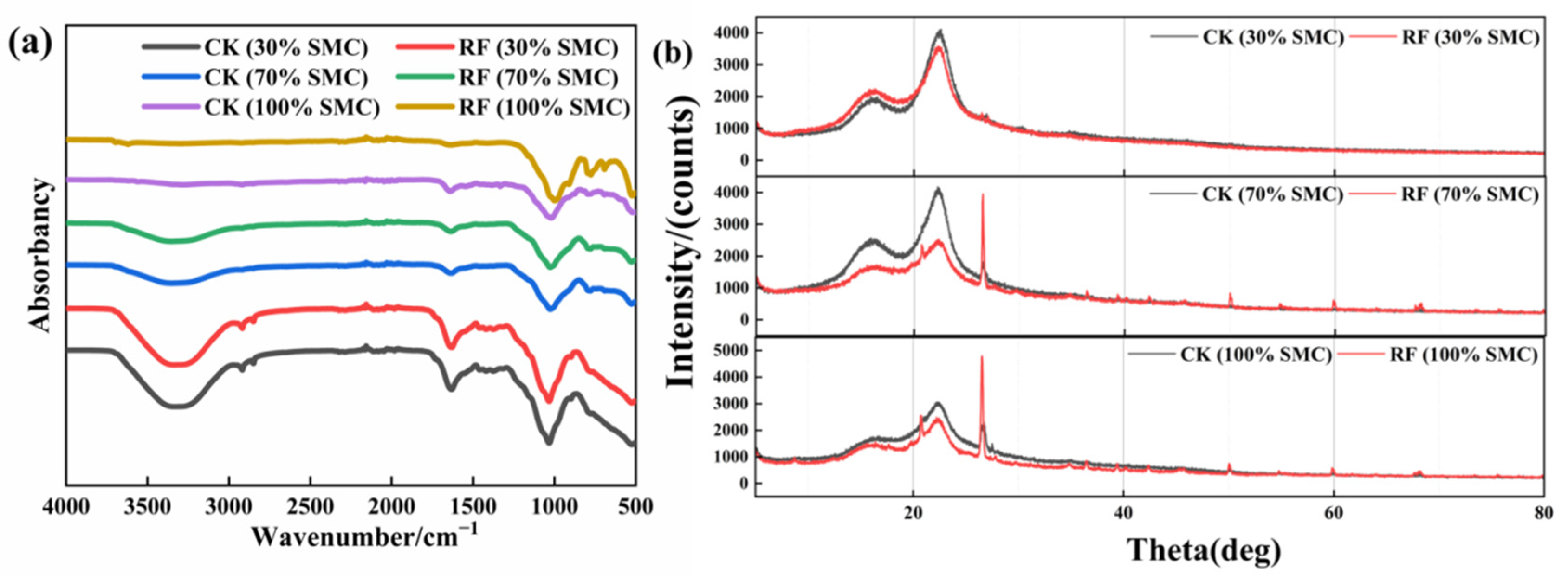
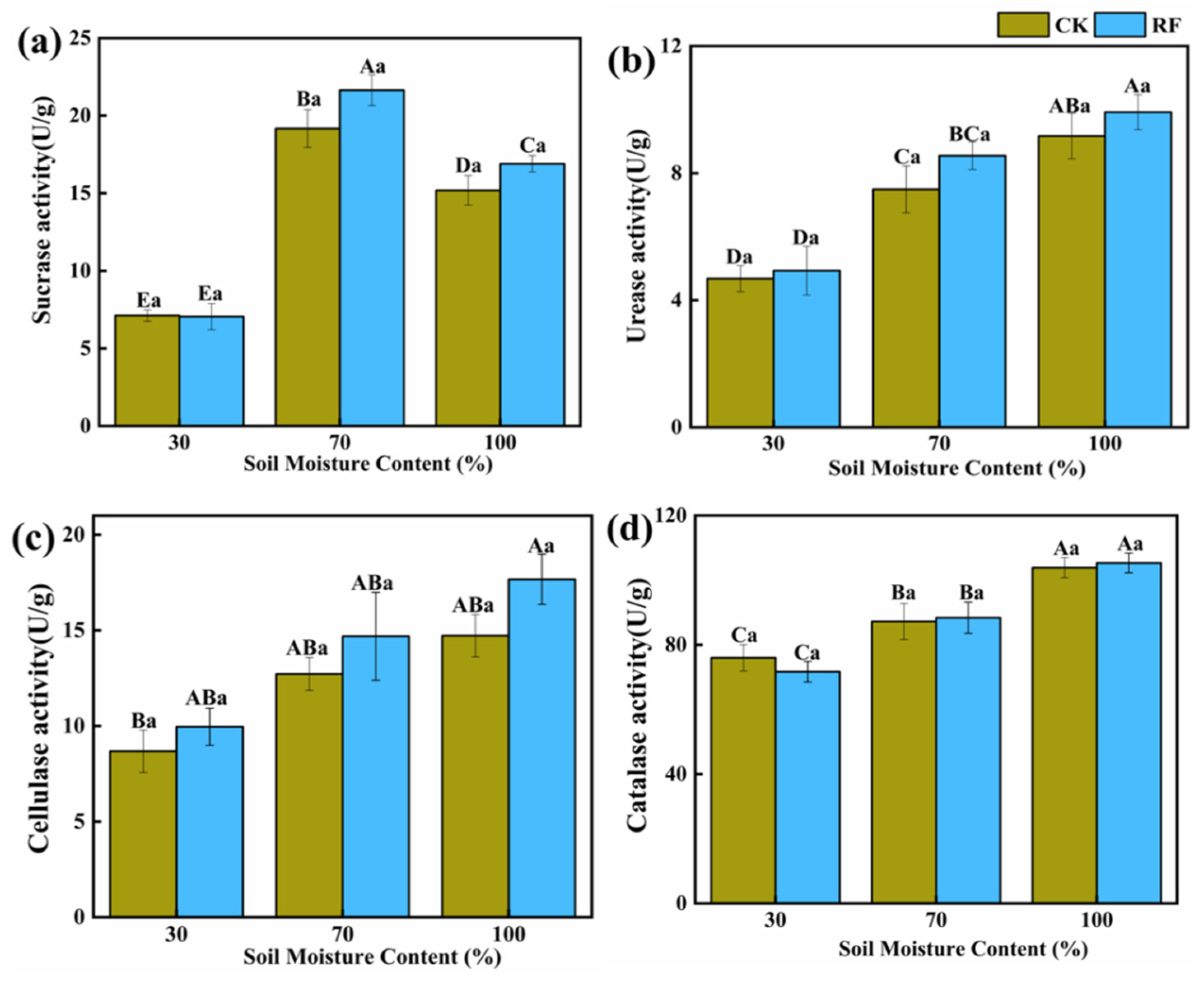
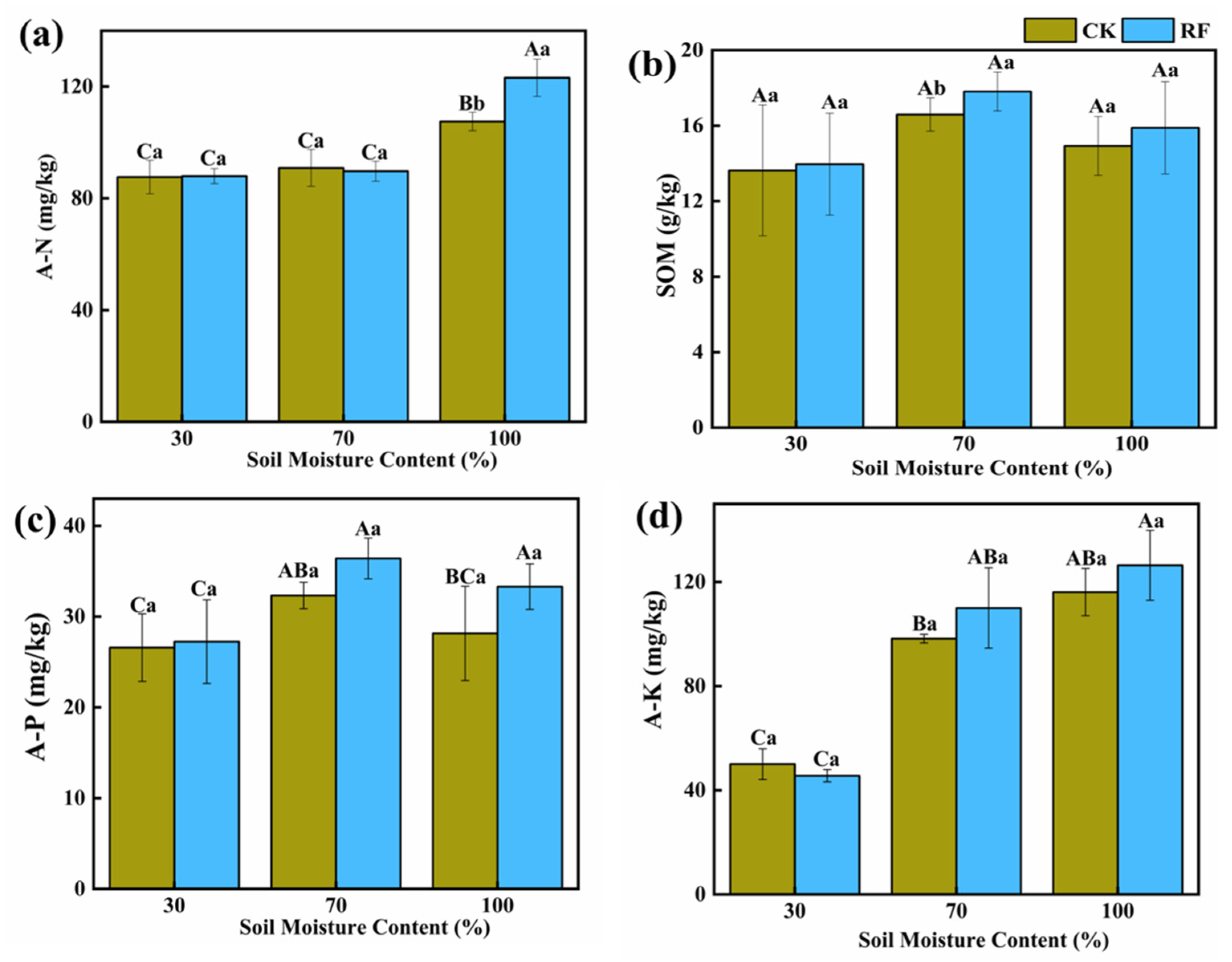
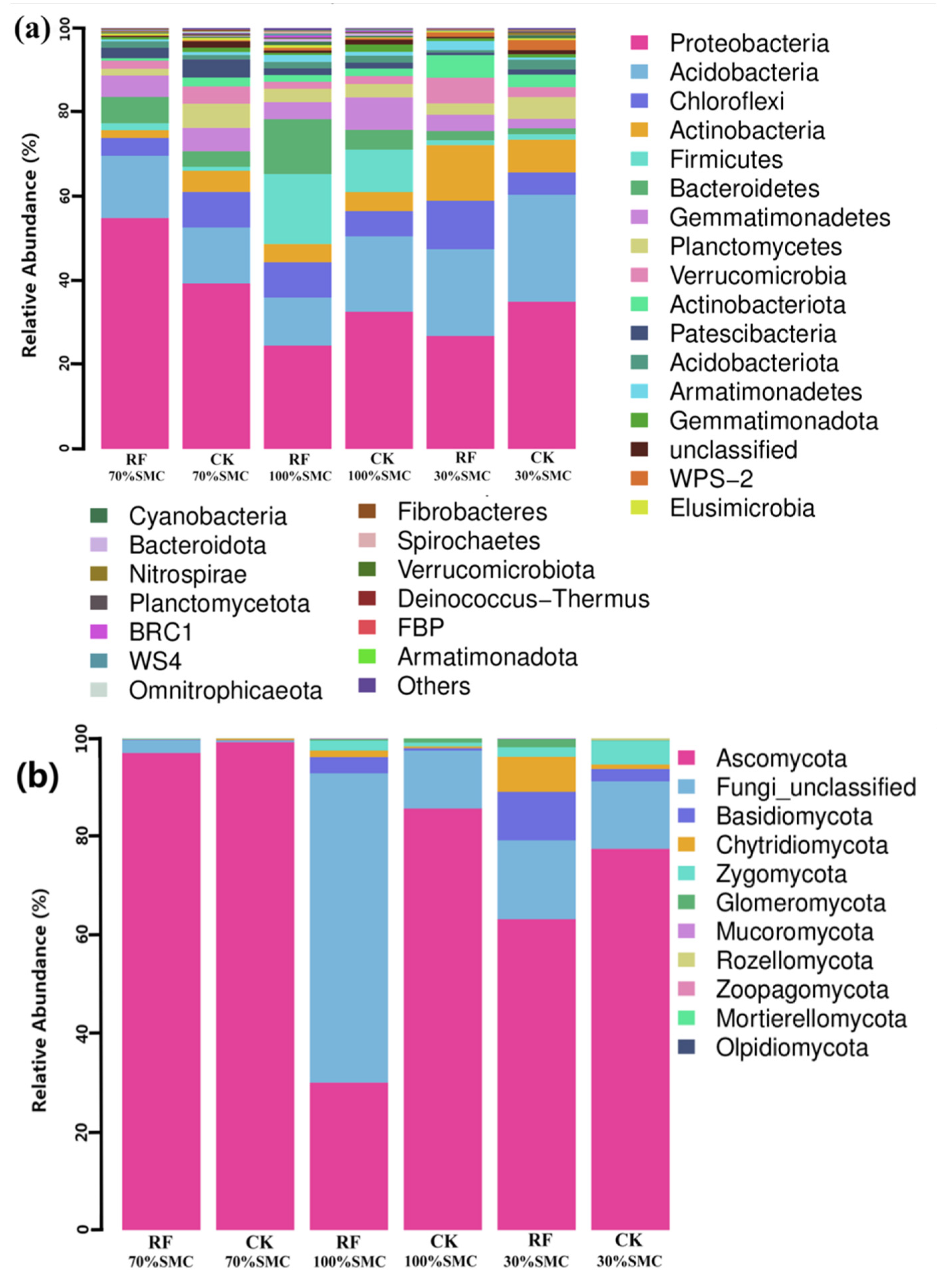
Disclaimer/Publisher’s Note: The statements, opinions and data contained in all publications are solely those of the individual author(s) and contributor(s) and not of MDPI and/or the editor(s). MDPI and/or the editor(s) disclaim responsibility for any injury to people or property resulting from any ideas, methods, instructions or products referred to in the content. |
© 2023 by the authors. Licensee MDPI, Basel, Switzerland. This article is an open access article distributed under the terms and conditions of the Creative Commons Attribution (CC BY) license (https://creativecommons.org/licenses/by/4.0/).
Share and Cite
Song, K.; Liu, S.; Ni, G.; Rong, Q.; Huang, H.; Zhou, C.; Yin, X. Effects of Different Soil Moisture Contents on Rumen Fluids in Promoting Straw Decomposition after Straw Returning. Agronomy 2023, 13, 839. https://doi.org/10.3390/agronomy13030839
Song K, Liu S, Ni G, Rong Q, Huang H, Zhou C, Yin X. Effects of Different Soil Moisture Contents on Rumen Fluids in Promoting Straw Decomposition after Straw Returning. Agronomy. 2023; 13(3):839. https://doi.org/10.3390/agronomy13030839
Chicago/Turabian StyleSong, Kailun, Shifei Liu, Guorong Ni, Qinlei Rong, Huajun Huang, Chunhuo Zhou, and Xin Yin. 2023. "Effects of Different Soil Moisture Contents on Rumen Fluids in Promoting Straw Decomposition after Straw Returning" Agronomy 13, no. 3: 839. https://doi.org/10.3390/agronomy13030839
APA StyleSong, K., Liu, S., Ni, G., Rong, Q., Huang, H., Zhou, C., & Yin, X. (2023). Effects of Different Soil Moisture Contents on Rumen Fluids in Promoting Straw Decomposition after Straw Returning. Agronomy, 13(3), 839. https://doi.org/10.3390/agronomy13030839





